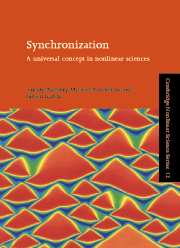Book contents
- Frontmatter
- Contents
- Preface
- Chapter 1 Introduction
- Part I Synchronization without formulae
- Part II Phase locking and frequency entrainment
- Chapter 7 Synchronization of periodic oscillators by periodic external action
- Chapter 8 Mutual synchronization of two interacting periodic oscillators
- Chapter 9 Synchronization in the presence of noise
- Chapter 10 Phase synchronization of chaotic systems
- Chapter 11 Synchronization in oscillatory media
- Chapter 12 Populations of globally coupled oscillators
- Part III Synchronization of chaotic systems
- Appendices
- References
- Index
Chapter 9 - Synchronization in the presence of noise
Published online by Cambridge University Press: 06 July 2010
- Frontmatter
- Contents
- Preface
- Chapter 1 Introduction
- Part I Synchronization without formulae
- Part II Phase locking and frequency entrainment
- Chapter 7 Synchronization of periodic oscillators by periodic external action
- Chapter 8 Mutual synchronization of two interacting periodic oscillators
- Chapter 9 Synchronization in the presence of noise
- Chapter 10 Phase synchronization of chaotic systems
- Chapter 11 Synchronization in oscillatory media
- Chapter 12 Populations of globally coupled oscillators
- Part III Synchronization of chaotic systems
- Appendices
- References
- Index
Summary
In previous chapters we considered synchronization in purely deterministic systems, neglecting all irregularities and fluctuations. Here we discuss how the latter effects can be incorporated in the picture of phase locking. We start with a discussion of the effect of noise on autonomous self-sustained oscillations. We show that noise causes phase diffusion, thus spoiling perfect time-periodicity. Next, we consider synchronization by an external periodic force in the presence of noise. Finally, we discuss mutual synchronization of two noisy oscillators.
Self-sustained oscillator in the presence of noise
No oscillator is perfectly periodic: all clocks have to be adjusted from time to time, some even rather often. There are many factors causing irregularity of self-sustained oscillators, for simplicity we will call them all noise. A detailed analysis of noisy oscillators must include a thorough mathematical description of the problem, where fluctuations of different nature (e.g., technical, thermal) should be taken into account. This has been done for different types of oscillators (see, e.g., [Malakhov 1968]); here we want to discuss the basic phenomena only.
As the first model, we consider a self-sustained oscillator subject to a noisy external force. In revising the basic equations of forced oscillators of Chapter 7, one can see that only the approximation of phase dynamics is valid in the case of a fluctuating force as well, since we do not assume any regularity of the force in the derivation of Eq. (7.15).
- Type
- Chapter
- Information
- SynchronizationA Universal Concept in Nonlinear Sciences, pp. 236 - 246Publisher: Cambridge University PressPrint publication year: 2001

